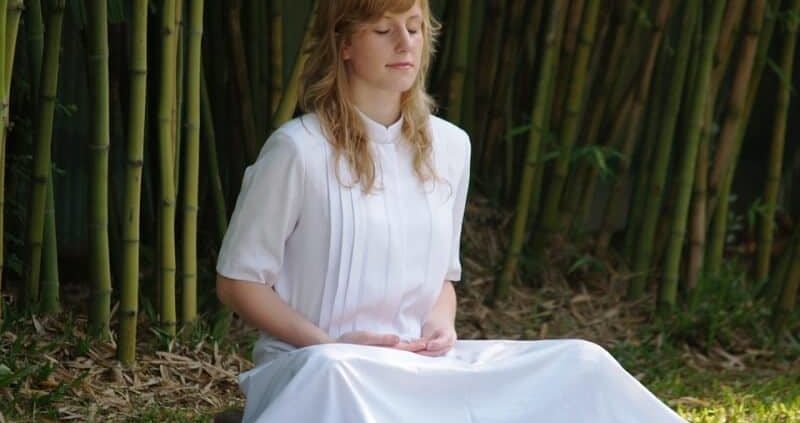Most of you probably have heard the word “Pranayama” or “Pranayam” often when someone talks about yoga. And many of you probably also know what it is.
But for those who do not know – “Pranayama” is an ancient yogic art/exercise which was designed to help the body and mind to relax through controlling one’s breathing.
The word “Pranayama” is a Sanskrit one which is composed of two smaller words. “Prana” meaning life force and “Ayama” meaning drawing out. Since Pranayama is a breathing exercise so that the word prana can refer to the breath as the life force and ayama relates to drawing breath.
It is a very ancient art which was developed in India. Pranayama is an excellent way to cure one of depression and anxiety. It also extends your longevity. It can keep your body healthy.
The control of breathing can keep your lungs and nervous system in a well-balanced state. It can also help cure some health problems like asthma, stomach disorders, diabetes, etc. and much more. Also, pranayama should always be done on an empty stomach in the mornings in the fresh air.
There are almost 50 different types of Pranayama. But in this article, you will read about the seven most popular types. Experts say that performing a handful of the pranayama techniques is enough to keep healthy! So below you will find the seven most popular pranayama techniques, their benefits and precautions as well (after all everything always has a catch)!
Read on!
Table of Contents
Seven Different Pranayama Techniques
The following seven different pranayama techniques will be discussed in this article.
- Bhastrika Pranayama
- Kapalbhati Pranayama
- Bahya Pranayama
- Anulom Vilom Pranayama
- Bhramari Pranayama
- Udgeeth Pranayama
- Pranav Pranayama
1. Bhastrika Pranayama
Bhastrika is an excellent breathing exercise. The word “Bhastrika” means bellows hence this exercise is also known as bellows breath. It can be done at a slower or faster pace as per one’s preference!
But it is better to start out slow at first then gradually increase the breathing speed to prevent hyperventilating in beginners. This technique should be practiced for at least 5 minutes twice per day.
How To Do Bhastrika Pranayama?
Follow the given steps to perform this breathing exercise properly.
- Sit down comfortably on a flat surface preferably the ground. If you can’t sit on the ground, sit on a chair. Keep your posture straight.
- Breath in deeply through both of your nostrils. Draw in the breath slowly until you feel that your lungs and abdomen has expanded fully.
- Breath out quickly through both your nostrils with a hissing sound. Exhale till you feel your lungs and abdomen have shrunk completely.
- This should be repeated for about 3-5 minutes every day for maximum benefits.
Benefits Of Performing Bhastrika Pranayama
- Bhastrika Pranayama helps improve the blood circulation of the body.
- It helps our mind and body relax. Also, improves concentration.
- It helps strengthen the nervous system. And also helps relieve tension, stress, depression, and anxiety.
- The breathing control helps strengthen the lungs and keeps heart problems at bay.
- It also cures throat infection, obesity, and arthritis.
- It increases proper appetite.
- It is a general cure for asthma.
Precaution
- Always remember to do this exercise in the morning or evening and on an empty stomach.
- People with heart and lungs problems and high blood pressure should try doing this exercise slowly. Do not try to be hasty.
- Pranayama should always be done under expert guidance. You should, at least, consult one before starting.
2. Kapalbhati Pranayama
Kapalbhati Pranayama is very effect cure for the many problems related to the stomach.
It has the potential to cure stomach problems like digestive disorders, obesity, gastric problems, etc.
If you are trying to lose a few pounds you can try this pranayama technique for added weight loss. Do it regularly to see benefits.
How To Do Kapalbhati Pranayama?
Follow the given steps to perform this breathing exercise properly.
- Sit down on the ground comfortably and keep your back straight. Fold your legs and keep both palms open face upon each knee.
- Now in this exercise, you should be emphasis on the exhalation of your breath.
- First inhales slowly through both nostrils, do not rush, take your time. Inhale till your lungs feel full, and your stomach/abdomen has stretched out. It should feel natural.
- Now forcefully exhale through your nose. The exhale should be quick and try using your stomach muscles to force out the air from your lungs. The exhale should be faster than the inhale.
- Repeat these steps. Do this breathing exercise slowly. Do not rush.
- Do this exercise for 15 minutes at least. You can take a 1-minute break after doing it for 5 minutes and then continue it. Gradually you can do it for 30 minutes.
Benefits Of Performing Kapalbhati Pranayama
- This exercise improves breathing and lungs and respiratory functions.
- It helps remove toxins from the body and helps the body in cleansing itself.
- It helps in weight loss.
- It is also supposed to help improve the reproductive function. In males, it can help in curing erectile dysfunction.
- It helps calm the mind and relax the body.
- Improves kidney function.
- It is very helpful for asthma patients and those suffering from other respiratory disorders.
- It is also said to be effective in curing stomach disorders like constipation, acidity, etc.
Precaution
- Heart patients should exhale slowly while doing this exercise.
- Pregnant women should not do this exercise.
- People having high blood pressure should do this exercise slowly and carefully.
- If you are female and on your periods, you can do this exercise or avoid it during this time. If you are comfortable doing it and experience no pain or discomfort, then you can do it.
- Always remember to do this exercise in the morning or evening and on an empty stomach.
- Pranayama should always be done under expert guidance. You should, at least, consult one before starting.
3. Bahya Pranayama
This Pranayama exercise is done by keeping the breath outside the body hence it is called Bahya Pranayama. “Bahya’ in Sanskrit means outside.
This pranayama should be done after you have done Kapalbhati Pranayama. It is said to be a very effective exercise for curing health problems like a hernia, stomach disorders, diabetes, etc.
How To Do Bahya Pranayama?
Follow the given steps to perform this breathing exercise properly.
- Sit down comfortably and take up the padmasana or siddhasana pose.
- Now take a deep breath in through both your nostrils and breath in as much as possible.
- Now exhale from your nose forcefully and empty your lungs as much as possible.
- While exhaling uses the muscles of your stomach to expel as much air as possible from your lungs.
- Now hold your breath and touch your chin to your chest.
- Hold this position and suck in your stomach in such a manner that there is hollow below your ribcage where the stomach muscles have been pulled inside, and it seems as if the stomach and back muscles are touching one another.
- Now hold this position and your breath for as long as you are comfortable (usually 10-15 seconds)
- Lift your chin up and breath in slowly while releasing your stomach muscles. Fill your lungs with air.
- Repeat this pranayama for 2-5 minutes every day to get benefits of this exercise.
Benefits Of Performing Bahya Pranayama
- Cures a hernia.
- Helps cure constipation, acidity, and other stomach disorders.
- Good cure for prostrate problems.
- It improves reproductive health and organs.
- Good exercise for those with diabetes.
Precaution
- If you are suffering from blood pressure problems, heart problems and cervical colitis you should avoid doing this pranayama.
- Women on their periods and those who are pregnant should not do this pranayama.
- Also, always do this exercise on an empty stomach with a 5-hour gap between practice and meals.
- Pranayama should always be done under expert guidance. You should, at least, consult one before starting.
4. Anulom Vilom Pranayama
This is a very effective pranayama which helps in purifying and relaxing your body and mind.
The exercise is very simple, and people of all ages can do this breathing exercise. This breathing exercise is also known as Nadi Shodhana. Practicing every day will keep your body and mind healthy and active throughout the day!
How To Do Anulom Vilom Pranayama?
- Follow the given steps to perform this breathing exercise properly.
- Sit down comfortably on the ground. If you cannot sit down, then sit on a chair.
- Close your eyes and concentrate on your breathing.
- Now for this exercise first, close your right nostril with your right thumb and breathe in deeply through the left nostril.
- Then close your left nostril with your index and middle finger of the same hand. If you wish, you can use both hands to block your nostrils in turns.
- Exhale slowly from the right nostril now. Exhale properly till you feel that your lungs have deflated completely.
- Now keep your right nostril open and inhale through it. Slowly inhale and fill your lungs completely.
- After inhaling close your right nostril this time and then exhale through your left nostril.
- This completes one round of Anulom Vilom Pranayama.
- Repeat this exercise for 5-10 minutes.
Benefits Of Performing Anulom Vilom Pranayama
- It is beneficial for improving blood circulation.
- It helps prevent heart problems.
- It also is good for the mind. Helps increase concentration.
- Help relieve stress, anxiety, depression, high blood pressure etc. Also improves nervous system functioning.
- It strengthens the lungs.
- Good for respiratory problems like asthma.
- Helps keep diabetes under control.
- Improves skin and gastric health.
Precaution
- Pregnant women should do this exercise in moderation. Do not over exert!
- Always remember to do this exercise in the morning or evening and on an empty stomach.
- Remember to do this exercise after 4-5 hours of having your food.
- Pranayama should always be done under expert guidance. You should, at least, consult one before starting.
5. Bhramari Pranayama
This pranayama is an excellent breathing exercise for calming the mind. It is very good for releasing negative energy, frustration, agitation and anger. “Bhramari” is a type of Indian Bee. The humming sound which is made during this exercise resembles that of the bees humming. Hence, this exercise has been naming Bhramari Pranayama.
How To Do Bhramari Pranayama?
Follow the given steps to perform this breathing exercise properly.
- Sit down in the padmasana or sukhasana position. Close your eyes and concentrate on your breathing.
- Now take both your hands and press the thumb of each hand to your ears. Your elbows should be in level with your shoulders.
- Place the index fingers on your forehead above each eyebrow and the rest of the fingers should be placed on your eyes.
- Now start inhaling through both the nostrils slowly and deeply.
- Exhale through your nostrils while making a humming sound like a bee from your throat.
- Repeat this for 3-5 minutes daily.
Benefits Of Performing Bhramari Pranayama
- Relief from stress, anxiety, tension and anger.
- Good cure for hypertension.
- Clears sinus blockages and problems.
- Strengthens the nervous system and calms the mind.
- Pregnant women can benefit from this breathing exercise.
Precaution
- People with heart problems should be careful while doing this exercise. Consult an expert.
- If you have ear problems, consult your doctor before doing this pranayama.
- Always remember to do this exercise in the morning or evening and on an empty stomach.
- Remember to do this exercise after 5 hours of having your food.
- Pranayama should always be done under expert guidance. You should, at least, consult one before starting.
6. Udgeeth Pranayama
This is another excellent breathing exercise. While doing this exercise one has to chant “Om” hence, this pranayama is also known as “Omkari Japa.” This exercise is simple and easy and old as well as young can do it. Practice daily for healthy body and mind.
How To Do Udgeeth Pranayama?
Follow the given steps to perform this breathing exercise properly.
- Sit down on the ground in a relaxed position.
- First, inhale deeply and slowly till your lungs is full.
- Now exhale slowly while chanting “Om”.
- Draw out the “Om” to “Ooooooooooom”, emphasizing on the O while keeping the M short.
- Repeat this for 5-10 minutes for added health benefits!
Benefits Of Performing Udgeeth Pranayama
- It is good for the mind. Clears the mind and improves concentration.
- It relieves the mind of tension, stress, anxiety, anger and depression.
- It helps control hypertension or high blood pressure.
- Good for the digestive problems like acidity etc.
- It helps cure insomnia.
Precaution
- Always remember to do this exercise in the morning or evening and on an empty stomach.
- Remember to do this exercise after 5 hours of having your food.
- Pranayama should always be done under expert guidance. You should, at least, consult one before starting.
7. Pranav Pranayama
This pranayama is a very simple one. It is to be done last after doing all the other six pranayamas. This is a simple breathing exercise which people of all age can do. This exercise is a sort of meditation.
How To Do Pranav Pranayama?
- Follow the given steps to perform this breathing exercise properly.
- Sit down in the padmasana, sukhasana or vajrasana position.
- This exercise requires you to breathe normally while concentrating on your breathing.
- Focus on your inhale and exhale and accept the natural spiritual energy entering your body.
- Do this exercise for 15 minutes or more.
Benefits Of Performing Pranav Pranayama
- It relieves the mind from stress, tension, anxiety, anger and all negative energies.
- Also, increases your physical and spiritual energy.
- Improves health and the mind.
- Increases concentration and strengthens the mind.
Precaution
- Always remember to do this exercise in the morning or evening and on an empty stomach.
- Do n’t forget to do this exercise in a fresh environment.
- Pranayama should always be done under expert guidance. You should, at least, consult one before starting.
Pranayama is an extremely healthy way to keep your mind and body in good shape. Everybody can do pranayama, excepting children younger than the age of 10 and old and weak people should not do pranayama as it does exert a certain amount of physical stress on the body.
Doing these seven pranayamas is enough to keep you healthy. Practice these daily in a clean and fresh environment.
Also, do consult an expert before you try it out! It will usually take up only 45 minutes to 1 hour of your time, and the benefits are numerous!






